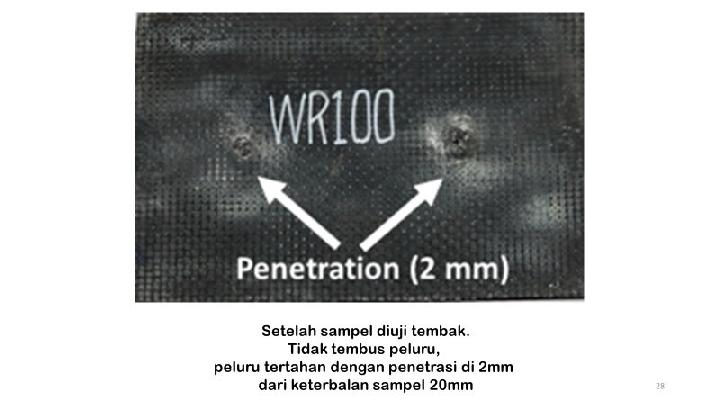ITB's Bulletproof Panel Withstands Sniper Shot From 5 Meters
Bulletproof panels made by ITB are made from local materials, namely rubber and hemp fiber. This panel that can replace imported kevlar has been tested by Pindad. (PHOTO/ITB)
The Bandung Institute of Technology (ITB) research team made bulletproof panels using local rubber and hemp fiber. The panel passed a shooting test with a sniper rifle from a distance of five meters.
"The speed of the bullet is up to 856 meters per second and does not penetrate, so we are happy with the result," said Team Leader Mardiyati to Tempo, Wednesday, January 12, 2022.
Apart from Mardiyati, the team also consisted of Ahmad Nuruddin, Arief Hariyanto, Steven, Onny Aulia Rachman, and Muhammad Hisyam Ramadhan, all of whom came from the Materials Polymeter Laboratory. The testing is in collaboration with PT Pindad.
The time of testing is on November 18, 2021, by Pindad staff, with bullets and rifles made by the weapons factory in Bandung. The type of weapon used is the SPR-3 caliber 7.62 millimeters.
During testing, the bullet-proof panel measuring 25.8 x 17 and 2.5 centimeters thick was shot at two points. The ITB research team brought five panel samples. Each panel has a different composition of local materials.
Usually, said Mardiyati, all bulletproof materials use imported materials. For example, Kevlar which uses an epoxy composite, or glass fiber with epoxy.
Starting from the literature study in mid-2020, the ITB team tried to replace it with local materials. The goal is to avoid dependence on foreign countries and comply with domestic component level regulations (TKDN), including for the military.
"Because this is a composite material, we see that natural rubber is very possible to dampen bullets," said Mardiyati. Rubber replaces epoxy, while flax fiber shifts the dominance of glass fiber (fiberglass).
Examples of panels that are made are made from 100 percent hemp fiber. In addition, there is a composition of hemp fiber material of 25, 50, and 75 percent, the rest is mixed with glass fiber.
From the test results, panels made of rubber with 100 percent hemp fiber were proven to fail to block bullets. "The limit is that half of the bullets can enter," said Mardiyati.
The panels with 25, 50, and 75 percent flax fiber successfully resisted bullets. From a panel thickness of 25 millimeters, the bullet only scratches with a depth of 2, 6, and 10 millimeters. "The bullet did not penetrate but stuck in the panel," he said.
The results are also juxtaposed with bulletproof materials which are all imported. Another advantage of the panel that passed the firing test is that it is lighter in weight.
On the 75 percent flax fiber panel, said Mardiyati, it weighs 965 grams. "But if 100 percent glass fiber is almost 1.5 kilograms or 1500 grams," he said.
ITB's Institute for Innovation and Entrepreneurship Development financed the research of this bulletproof panel from natural and local materials with a fund of Rp 150 million.
Other uses, for example, are to protect the underside of helicopters, detention houses, or shelters. However, Mardiyati revealed, recently there was an architect consultant who wanted to discuss the possibility of installing bulletproof panels on the wooden house design.
"It can also be used for vehicles, whether on the door or otherwise, the panels can still be shaped according to the contours because they are flexible and made of natural rubber," added this female doctoral researcher.
The composition of other ingredients is flax fiber 25, 50, or 75 percent, the rest is glass fiber. The advantages of composite materials, he said, "We can adjust to what needs and specifications."
The panel underwent a firing test according to military standards at PT Pindad, Bandung, last November. During the test, the ITB team brought five samples of bulletproof panels, each measuring 25.8 x 17 with a thickness of 2.5 centimeters.
Each panel with a different composition of materials, each shot twice at a different point from a distance of 5 meters. The type of weapon used is the SPR-3 caliber 7.62 millimeters by snipers.
From the test results, the team together with the Institute for Innovation and Entrepreneurship Development, ITB, which financed the research, wanted the panels to be produced. "It can also be made by a local company, we just sell the license," said Mardiyati.
Regarding the price in the market, he hopes to be cheaper than imported products because the main ingredients such as natural rubber and hemp fiber are available in Indonesia.




